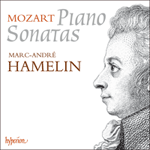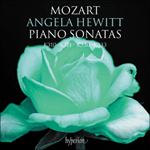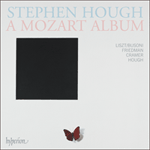
Welcome to Hyperion Records, a British classical label devoted to presenting high-quality recordings of music of all styles and from all periods from the twelfth century to the twenty-first.
Hyperion offers both CDs, and downloads in a number of formats. The site is also available in several languages.
Please use the dropdown buttons to set your preferred options, or use the checkbox to accept the defaults.

This is a work that seems to increase in scope as it unfolds, and once again memories of the opera house are never far below the surface, with an agitated minor-mode development section, where syncopated right-hand writing is set against restless semiquavers in the left hand, while the composer exploits the contrast of registers to the full. The recapitulation relaxes into the graceful opening theme, and the movement ends in a mood of benign serenity. The Andante cantabile unfolds at an unhurried pace, balancing tenderness with a certain solemnity. By contrast, the high-kicking finale takes off in a quite different direction. It is a concerto allegro in all but name, with clearly defined passages of solo and tutti writing, accents, dramatic silences and terse phrasing all adding spice. Even brief excursions into the minor can’t displace its ebullience for long, and Mozart adds a full-blown cadenza for good measure, in which major and minor battle it out beneath a soaring, trilling operatic line. Light triumphs over darkness as the opening theme is recalled, heralding a simple but emphatic ending.
from notes by Harriet Smith © 2008
Voilà une œuvre qui semble gagner en envergure à mesure qu’elle se déploie et, là encore, les souvenirs de l’opéra ne sont jamais bien loin, avec une section de développement agitée en mode mineur, où une écriture syncopée de la main droite est posée contre d’incessantes doubles croches à la main gauche, tandis que le contraste des registres est exploité au maximum. La réexposition se relâche dans le gracieux thème d’ouverture et le mouvement s’achève dans une douce sérénité. L’Andante cantabile s’épanouit en toute tranquillité, balançant la tendresse par une certaine solennité. Par contraste, le finale pétulant prend une tout autre direction. Ce n’est pas un allegro de concerto, mais c’est tout comme, avec des passages de solo et de tutti clairement définis, des accents, des silences dramatiques et un phrasé laconique mettant un peu de sel. Même les brèves incursions en mineur ne peuvent supplanter longtemps son bouillonnement; puis, pendant qu’il y est, Mozart ajoute une cadenza complète, dans laquelle majeur et mineur bataillent sous une ligne opératique qui file et trille. La lumière triomphe des ténèbres lorsque le thème d’ouverture est rappelé, annonçant une conclusion simple mais appuyée.
extrait des notes rédigées par Harriet Smith © 2008
Français: Hypérion
Dies ist ein Werk, das sich in seinem Verlauf immer weiter zu entfalten scheint, und wiederum liegen die Erinnerungen an die Oper nie weit unter der Oberfläche, mit einer aufgeregten Moll-Durchführung, wo synkopierte Schreibweise für die rechte Hand rastlosen Sechzehnteln in der linken entgegengesetzt sind, während der Komponist den Registerkontrast voll ausnutzt. Die Reprise löst sich in das grazile Anfangsthema auf, und der Satz schließt in heiterem Wohlmut. Das Andante cantabile entfaltet sich in gemütlichem Tempo, und Zartheit und eine gewisse Feierlichkeit halten sich im Gleichgewicht. Das übermütige Finale geht in eine ganz andere Richtung. Es ist praktisch ein Konzert-Allegro mit genau definierten Passagen von Solo und Tutti, denen Akzente, dramatisches Schweigen und straffe Phrasierung Würze geben. Selbst kurze Ausflüge nach Moll können diesen Übermut nicht lange verdrängen, und um das Maß voll zu machen, fügt Mozart noch eine ausgewachsene Kadenz ein, in der Dur und Moll unter einer hochfliegenden, trillernden, opernhaften Melodie fechten. Licht triumphiert über Dunkelheit, wenn das einleitende Thema zurückkehrt und einen schlichten, emphatischen Schluss ankündigt.
aus dem Begleittext von Harriet Smith © 2008
Deutsch: Renate Wendel
 Mozart: Piano Sonatas Mozart: Piano SonatasEight Sonatas, two Rondos, a Gigue and a Fantasia—the unique Marc-André Hamelin.» More |
 Mozart: Piano Sonatas K310-311 & 330-333 Mozart: Piano Sonatas K310-311 & 330-333Angela Hewitt’s voyage through Mozart’s piano sonatas is proving a joy, the works sounding newly minted in these vital, alert accounts.» More |
 Mozart: Stephen Hough's Mozart Album Mozart: Stephen Hough's Mozart AlbumHyperion is delighted to present an eagerly awaited recital disc from Stephen Hough. This fascinating programme begins with some of Mozart’s most audacious and forward-looking piano works. The second part of the disc features Mozart as seen by others ...» More |

